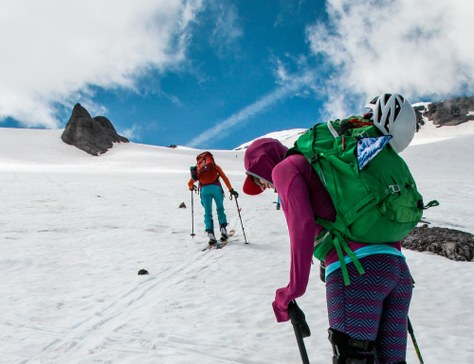In this piece, guest writer Teresa Hagerty explains Backcountry Hygiene 101 and shares her tips on how to stay fresh(ish) on long trips into the backcountry. Because you don’t have to smell bad to smell better.
Hello gorgeous! You – yes, you! With the messy hair, dirty legs, and that certain wilderness glow about you. You look fabulous!
You can absolutely look and smell great in the backcountry. The amenities of your million-star hotel can include everything you need for clean skin, sparkling teeth, and mostly inoffensive aromas. These are the tips you need to maintain good hygiene in the backcountry. Learn how to stay fresh(ish) with the right combination of tools, know-how, and Leave No Trace practices.
BODY ODOR PREVENTIONS
CLOTHING
The best offense is a good defense. Minimizing body odor and bacterial growth begins with your clothes. I rely on wool or wool blend base layers for all multi-day trips. This includes all base layer shirts, socks, and underwear. Wool and wool blends have a natural resistance to bacteria, including the body odor-causing staphylococcus hominis, are naturally quick-drying, and retain their warmth when wet. Fellow adventurers on a month-long trek in Nepal recently put this to the test, wearing nothing but the same wool base layer shirt every day. I can attest that they were amongst the least offensive trekkers around the dinner table. Wool works!
BATHING
It goes without saying that most backcountry adventurers don’t have regular access to showers. But that doesn’t mean you can’t bathe, you gorgeous filthy animal. My daily backcountry backcountry hygiene routine starts as soon as I arrive at camp. My first priority is drying my feet to reduce odors, minimize the risk of athlete’s foot, and reduce the chance of blisters. I then change into dry socks and breathable camp shoes (I prefer lightweight, close-toed Crocs). I also wipe my face and hands with a rehydrated unscented wet wipe (ex. Wysi Wipes).
A warm day and early arrival to camp may also allow for a full backcountry bath. A backcountry bath requires a spot a minimum of 200 feet away from natural water sources, a pack towel or bandana, water, and biodegradable, unscented soap (scented soap not only has the potential to attract animals, but can damage the environment). A few drops of Dr. Bronner’s soap and a splash of water on a pack towel or rehydrated wipe is all it takes to get started. I recommend moving from your face to your hands, then torso, legs, and underarms before wiping down your bathing suit area. Finally, rinse your pack towel and wash your feet. Complete with a full-body rinse (not in a stream or river!) or by wiping down with a fully-rinsed pack towel.
Wet-Wipe Time
A great substitute for a full backcountry bath is some quality wet wipe time in your tent. I schedule these right before bedtime. This alternative doesn’t use soap (it could introduce odors into your tent), but you can still make a big difference with only a wipe and water. The same top-down order applies. I use one rehydrated wipe for my face and hands, a second for my body, a third for the sensitive bits, and a fourth for my feet. The tent bath is immediately followed by changing into dry socks, dry underwear, and sleep clothes. It’s important to sleep in dry socks and underwear to minimize the growth of humidity-loving bacteria. Excess bacteria can quickly lead to increased body odor, fungal growth, yeast and UTI infections, and other unpleasant things. Control what you can – dry clothes are a great proactive move.
BACKCOUNTRY LAUNDRY
On long-distance treks you may reach the clothing breaking point. You can only stretch the same shirt, underwear, and socks for so many days before backcountry laundry must be done (this is four days for me, since we’re sharing). It’s relatively easy to do with a gallon-sized bag, a few drops of biodegradable soap, and water. Add a few items of clothing into the bag with a few drops of soap and about two cups of water. Agitate the dirty clothing for a couple of minutes and disperse the wastewater at least 200 feet away from natural water sources. Clean laundry items may be dried on a paracord laundry line or clipped to your backpack with safety pins or carabiners.
THE BACKCOUNTRY BATHROOM
Welcome to the awkward part of the conversation: the backcountry bathroom. Let’s get into it.
PEEING
Let’s start with the easiest to address: peeing. This topic gives me occasional envy of the menfolk in my life for whom peeing in the woods can be as simple as finding a semi-private spot. Yeah, I’m jealous.
Peeing in the woods is a bit more complicated for women. It’s important for women to wipe or dab away excess moisture to reduce the chance of bacteria growth in a vulnerable location. Dry yourself with either toilet paper or a reusable pee cloth. I’m a huge fan of the reusable and antibacterial Kula Cloth, which also reduces the volume of used toilet paper to pack out. Pee funnels are a good alternative too. Follow the same Leave No Trace principles as the menfolk.
POOPING
Dealing with solid waste in the backcountry is a more complicated proposition. All solid waste – human or canine – must be disposed of appropriately. This means depositing solid waste in an established backcountry privy, burying it in an appropriately-dug cathole, or carrying it out in a blue bag. Pack out all toilet paper. Please visit The Mountaineers low impact recreation videos for more information on this topic.
Maintain backcountry hygienic and responsible practices by always packing out your toilet paper, employing a backcountry bidet, and using hand sanitizer. A backcountry bidet is a game-changer, and you can hack a reliable one with a lightweight 4 oz. Nalgene flip-top squeeze bottle. Use it by manually squirting water onto yourself and repeating as needed. The backcountry bidet reduces odor-causing residue, the risk of UTI infections, and the dreaded monkey butt. It’s worth its weight in gold.
All solid waste-related events should be followed by hand washing, and if possible using hand sanitizer as well. As a dear friend and physician says, do not close the fecal-to-food loop. Ever.
PERIODS
Ladies, promise me, pinky swear, right now that you will always pack it out. Do not dispose of used feminine products in backcountry privies or pit toilets (unless you want some poor ranger to fish it out). Luckily, a few items make packing out used feminine products less traumatic. And I recommend either a double-layer Ziploc system, with used feminine products placed in an inner bag inside of a duct tape-covered outer bag, or an inner bag inside of an odor-proof OpSak. Menstrual cups are also a good option. Follow the same disposal methods for solid human waste. Keep in mind that menstrual cups must be rinsed each time, and washing with soap or boiling is recommended to keep bacteria levels low to avoid infection. Rinse it thoroughly and make sure soap is always kept outside of our bodies.
GO FORTH AND BE CLEAN
Real talk: I may or may not bother with a backcountry bath, laundry, or clean underwear during a short 2-3 day outdoor adventure, but I am religious about the unscented wet wipe bedtime routine. There is a fine balance between maintaining hygiene standards and embracing the true freedom of the hills, and that balance is highly personal. For me, this freedom includes the liberty to be dirty, go to bed with pine needles in my hair, and wake up smelling like earth. Now go forth and embrace your own version of backcountry fabulous.
BACKCOUNTRY HYGIENE TOOL KIT
Maintain effective backcountry hygiene on every adventure with these items:
- Liquid hand sanitizer
- Dehydrated wet wipes (ex. Wysi Wipes)
- Pack towel – ultralite, face sized
- Dr. Bronner’s Castile soap – unscented, 2 oz.
- Mini toothbrush and toothpaste
- Bathroom kit: toilet paper, Ziploc one-quart trash bag, trowel (ex. Duece of Spades)
- Backcountry bidet – 4 oz. Nalgene flip-top bottle
- Pee cloth (ex. Kula Cloth) or pee funnel (ex. Freshette)
- Feminine hygiene products (ex. tampons, pads, or menstrual cup)
Erin Sweatland taking her Kula Cloth for a ski tour on Inter Glacier. Photo by Kristen Connolly.
Founder of Cascade Mountain Adventures, Teresa Hagerty is proud to share outdoor skills with women in the Pacific Northwest and encourage them in their adventures. Her personal time is spent mountaineering, cycling, backpacking, snow camping, and reveling in all things outdoors in the great Pacific Northwest. Read more of Teresa’s fantastic writing on The Mountaineers website. And on a personal note, I’ve never had a guest blogger before, and I was thrilled when Teresa agreed to be my first. I have a total writer crush on her and am thrilled to share her work here. If you’re looking for a fantastic and supportive backcountry guide with just the right amount of sass, she’s got you!
This article originally appeared in The Mountaineers Spring 2020 issue of Mountaineer Magazine. To view the original article in magazine form and read more stories from our publication, visit our magazine archive.






